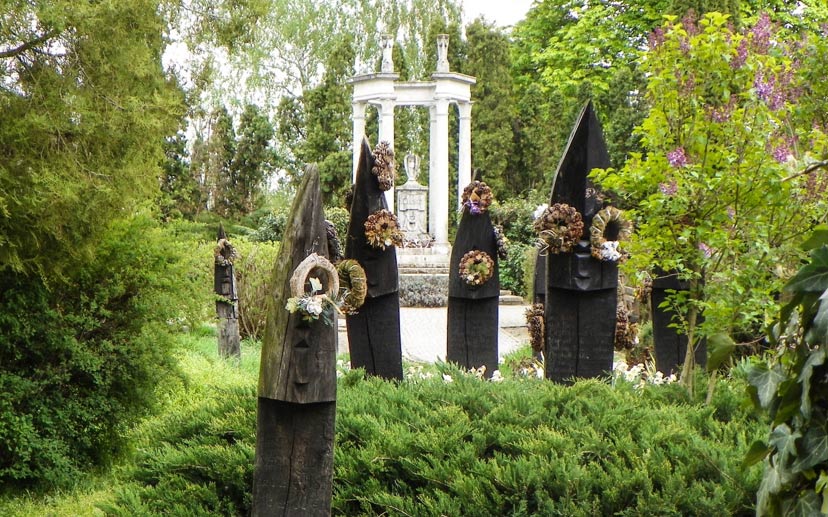Szatmarcseke: A Small Village with a Cemetery of Upturned Boats
Szatmárcseke is a small village in the north-east of Hungary, located close to the border of Ukraine. The cemetery, located to the rear of the Calvinist Church, is rather unusual in that nearly all the grave markers are carved from dark oak in the shape of upturned boats bearing human-like faces with the prow of the boat facing skywards.

Location of Szatmárcseke (Google Maps)
No one knows why this tradition started, but one story is that after the village flooded the roads were impassable and the survivors floated the drowned victims to their burial sites on vessels which were subsequently up-ended and used as headstones. Another theory is that the boats symbolize an old belief that death is part of a journey. Some people think the roots of this practice is a centuries-old tradition and a way of preserving the ancient Finno–Ugric (ancestral Hungarian) custom of burying the dead in boats to journey to the after-life, while others vehemently disagree with this version.
Several of the graves are marked with notches which are thought to represent symbols detailing the deceased’s marital status, social position and also provide other facts about the person. But the meanings have become lost.
The simplest inscriptions on the grave markers state the name of the person, the dates of birth and death, and the main events of their life. These are described in short, often humorous and affectionate verse, and accompanied by letters such as ABFRA (in the hopes of a happy resurrection) and BP (peace pairs). The more elaborate markers are engraved with a circle of stars, flowers, and tools which may have been related to the person’s former trade.

Boat Grave Markers At Szatmárcseke Cemetery (Kozsup, E.N. / Pinterest)
Despite the tradition’s murky history which is unique in Hungary, the practice continues to this day. Residents of the village consider the markers an important part of their culture and customs and before a resident of the area dies, they select a tree that will one day be felled to form his or her own marker. The residents also leave specific instructions with their chosen carpenter. The boat-shaped pieces of wood, however, must meet a strict set of criteria: They must be made of oak, they must be between about five and six feet high (in keeping with the others), and they must face west.
Located in a separate area which was once reserved for Romani Hungarians and the victims of suicide are some of the oldest boat markers in the cemetery.
- The Misnomer of Gypsies: The Real History of the Romani People
- The Dramatic and Intensely Moving Monumental Cemetery of Staglieno
- Nine Weird and Wonderful Facts about Death and Funeral Practices
And if you would like your own boat grave marker, a local woodcarver who lives close to the cemetery sells small hand-carved models as souvenirs.
From the Unknown to the Beloved Kölcsey
Besides peculiar grave markers of unknown origin, the cemetery contains the tomb of a very well-known Hungarian poet, Ferenc Kölcsey.

Ferenc Kölcsey (Public Domain)
Born in 1790, Kölcsey’s early life was not an easy one. He lost an eye to smallpox and when he was orphaned at age twelve he was adopted by his brother-in-law. Throughout his life his health was fragile and he was often ill. He never married and very little is known of his private life.
Kölcsey studied law but didn’t finish his degree since his real interest lay in the Hungarian language-reform. The poet made a lasting impression on the reform and the spread of the Magyar language (the Hungarian name for their language.) He retired to his estate in 1815 and in 1823 wrote what was to become the Hungarian National Anthem.
When Kölcsey died in 1838 at the young age of 48 years old, he was buried next to his brother, Adam, and he was well remembered by his peers and more particularly close friends who shared his passion for literature.
His tomb is surrounded by white neo-classical columns and takes pride of place, situated on a hill in the middle of the cemetery. An exhibition in the cultural center commemorates his time spent in Szatmárcseke.
Top image: Szatmárcseke Cemetery Source: (Mihaly Gazso / Pinterest)
References
Andrasta.: Szatmárcseke Calvinist Cemetery. AtlasObscura
Available at: https://www.atlasobscura.com/
Kibelbeck, M. 2017: Writer’s Home – Where Kölcsey rests. Cultura.hu
Available at: http://cultura.hu/kultura-plusz/irok-otthona-ahol-kolcsey-nyugszik/
Mena, D. 2007. Adventure Guide to Hungary. Hunter Publishing Inc.

















